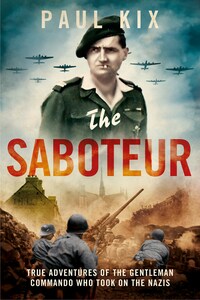William Collins
An imprint of HarperCollinsPublishers
1 London Bridge Street
London SE1 9GF
www.WilliamCollins.co.uk
This eBook first published in Great Britain by William Collins in 2017
Copyright © Paul Kix 2017
Cover images planes and street © Alamy; Soldiers © Getty Images
Cover design by Leo Nickolls
Paul Kix asserts the moral right to be identified as the author of this work
A catalogue record for this book is available from the British Library
All rights reserved under International and Pan-American Copyright Conventions. By payment of the required fees, you have been granted the non-exclusive, non-transferable right to access and read the text of this e-book on-screen. No part of this text may be reproduced, transmitted, down-loaded, decompiled, reverse engineered, or stored in or introduced into any information storage and retrieval system, in any form or by any means, whether electronic or mechanical, now known or hereinafter invented, without the express written permission of HarperCollins
Source ISBN: 9780007553808
Ebook Edition © December 2017 ISBN: 9780007553815
Version: 2017-11-29
Contents
Cover
Title Page
Copyright
Dedication
Author’s Note
Prologue
Chapter 1
Chapter 2
Chapter 3
Chapter 4
Chapter 5
Chapter 6
Chapter 7
Chapter 8
Chapter 9
Chapter 10
Chapter 11
Chapter 12
Chapter 13
Chapter 14
Chapter 15
Chapter 16
Chapter 17
Chapter 18
Chapter 19
Chapter 20
Chapter 21
Chapter 22
Epilogue
Acknowledgments
Notes
About the Author
About the Publisher
This is a work of narrative nonfiction, meant to relay what it was like for Robert de La Rochefoucauld to fight the Nazis from occupied France as a special operative and résistant. I relied on a few primary sources to tell this story, most notably La Rochefoucauld’s memoir, La Liberté, C’est Mon Plaisir: 1940–1946, published in 2002, a decade before his death. La Rochefoucauld’s family, ever gracious, also gave me a copy of the audio recording in which Robert recounted his war and life for his children and grandchildren. This was great source material, as was a DVD I received, which was directed, edited, and produced by one of Robert’s nephews, and which tells the tale of his storied family, specifically his parents, his nine brothers and sisters, and the courage that Robert himself needed to fight his war. The DVD, like the audio recording, was made for the La Rochefoucauld family to share with successive generations, but Robert’s daughter Constance was kind enough to make me a copy.
I spoke with her and her three siblings at length about their father—in person, over Skype, on the telephone, and by email. I kept contacting them long after I said I would, and kept apologizing for it. But Astrid, Constance, Hortense, and Jean were always amenable and happy to share what they knew. I’m eternally grateful.
This narrative is the result of four years of work, with research and reporting conducted in five countries. I talked with dozens of people, read roughly fifty books, in English and French, and parsed thousands of pages of military and historical documents, in four languages. Despite all this, and no doubt because of the secret nature of La Rochefoucauld’s work, there are certain instances where Robert’s account of what happened is the best and sometimes only account of what happened. Thankfully, in those spots, Robert’s recollections are vivid and reflect the larger historical record of the region and time.
PAUL KIX, JANUARY 2017
His family kept asking him why. Why would a hero of the war align himself with one of its alleged traitors? Why would Robert de La Rochefoucauld, a man who had been knighted in France’s Legion of Honor, risk sullying his name to defend someone like Maurice Papon, who had been charged, these many decades after World War II, with helping the Germans during the Occupation?
The question trailed La Rochefoucauld all the way to the witness stand, on a February afternoon in 1998, four months into a criminal trial that would last six, and become the longest in French history.
When he entered the courtroom, La Rochefoucauld looked debonair. His silver hair had just begun to recede, and he still swept it straight back. At seventy-four, he carried the dignified air of middle age. He had brown eyes that took in the world with an ironic slant, the mark of his aristocratic forebears, and a Roman, ruling-class nose. His posture was tall and upright as he walked to the stand and gave his oath and, lowering himself to his seat at the center of international attention, he appeared remarkably relaxed—his complexion even had a bronze tint, despite the bleak French winter. He remained a handsome man, nearly as handsome as he’d been in those first postwar years, when he’d moved from one girl to the next








